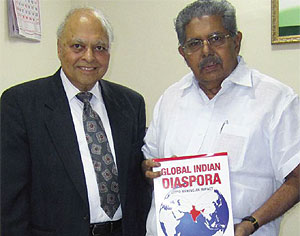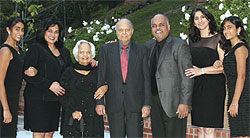You have been part of the Pravasi movement in a big way. Please talk us through the initial years…
For the first time in the history of overseas Indians, a successful attempt was made in 1989 to bring the global Indian community together on one platform. The National Federation of Indian American Associations (NFIA), a national body of people of Indian origin in the USA, which was headed by Inder Singh, organized the First Global Convention of People of Indian Origin (PIO) with Dr. Thomas Abraham as the convention convener. At the conclusion of the five-day convention, the Global Organization of People of Indian Origin (GOPIO) was formed. Fourteen years later in 2003, Government of India organized a convention of overseas Indians, called Pravasi Bhartiya Divas which is now a highly-promoted annual event.
How much has the Diaspora gained from it?
GOPIO’s initial mission was to address the interests and concerns of overseas Indians—people of Indian Origin (PIOs) and Non-Resident Indians (NRIs). GOPIO, since its inception, has been creating awareness and promoting understanding of issues of concern—social, cultural, educational, economic, and political—of the NRI/PIO communities around the globe. GOPIO also provides an active and well-recognized platform for dialogue and discussion to the worldwide Indian Diaspora and to further advance that objective, GOPIO has been at the forefront to network the globally spread overseas Indian community by regularly organizing conferences in various parts of the world. GOPIO conferences and conventions have helped bring the Indian Diaspora closer to mother India and have strengthened the inherent bond between India and its Diaspora. After all, the destiny of India's Diaspora, in many ways, is intertwined inextricably with India.

Mr Inder Singh presents a copy of the book titled Global Indian Diaspora—GOPIO Making An Impact to Minister for Overseas Indian Affairs, Mr Vayalar Ravi, in New Delhi
You took over as GOPIO President exactly 10 years ago. Please talk through the contributions made during that decade…
Yes, in January 2004, I took over as GOPIO president. It was a daunting task for me to revitalize GOPIO by starting chapters in various cities in countries with substantial NRI/PIO population. During the five years of my presidency, I tirelessly worked and succeeded in starting over 50 chapters in various countries. I started several Councils (departments of GOPIO) to serve the diverse interests of the global Indian community. I brought about several organizational changes to accommodate expansion. With the increase in the number of chapters and Councils and their activities and involvement of more volunteers, the new GOPIO widened its outreach and enlarged its activities manifold. GOPIO chapters and Councils—Cultural, Academic, Philanthropic, Human Rights, Media, Health Services, Youth and Women’s – have several opportunities for continuous involvement of the members of the Indian Diaspora to serve the diverse interests of the global Indian community. GOPIO continues to take up issues of the NRI/PIO Communities and lobbies for their resolution.

(L-R): Tara Jyote (grand daughter), Mollie (daughter), Deepi Singh (wife), Inder Singh, V.J. Singh (son), Simran (daughter-in-law), Sasha Jyote (grand daughter)
Please talk us through the planning and execution of the Gadar programmes held by GOPIO International in 2013…
Our efforts to get recognition for Gadar heroes began in 2003 when GOPIO in collaboration with the National Federation of Indian Associations (NFIA) organized the 90th anniversary of the Gadar movement in Fremont, California. Former president K.R Narayanan made a special trip to the US to be the chief guest for the anniversary event.
In June 2011, we started asking the Government of India to commemorate the centenary of the Gadar movement in a befitting manner. We contacted India’s Consul General in San Francisco, India’s ambassador, some ministers in India and sent a request to the prime minister’s office (PMO). After relentless pursuit, the PMO agreed to make the Gadar centenary as part of Parvasi Bharatiya Divas in 2013.
Prime Minister Dr. Manmohan Singh recognized the Gadar movement as part of India’s independence movement at the 2013 Parvasi Bharatiya Divas. In his speech, the prime minister said, “This year, we are celebrating the centenary of the Gadar Movement, which was a luminous spark of support in distant California for the struggle for independence being waged at home in our country. Apart from commemorating it by the issue of a special postage stamp, we will also upgrade the Gadar Memorial in San Francisco into a functional museum and library with a sculpture to honor the Gadari Babas, the heroes of the great movement.”
Please give us a background of the Gadar movement…
The Gadar movement was started by NRIs on the West Coast of America and Canada to throw the British out of India.
In 1913, immigrants from India formed the Hindustan Association of the Pacific Coast in Astoria, Oregon, to liberate India from British colonialism. Its headquarters was established in San Francisco from where a magazine titled Gadar was also launched. Gadar magazine became very popular among Indians in a short period of time and the Hindustan Association of the Pacific Coast itself became known as the Gadar Party under the leadership of Lala Har Dayal and Sohan Singh
Bhakna.
As many as 8,000 Indians went back to India from all over the world to throw the British out of India. Their attempt did not succeed and they paid a heavy price for their valiant effort: 46 were given the death sentence, 69 were given life imprisonment, over 125 were given varying terms of imprisonment, 15 were convicted in the Hindu-German Conspiracy Trial in San Francisco and several people from the armed forces were court-martialled in India.
Gadar Centennial Commemoration is a GOPIO initiative in our effort to preserve and promote Indian history and culture.
—Mr Inder Singh will be delivering a special address at the first Global Indian
Business Conference being held on January 10, 2014 at the Federation House,
Tansen Marg, New Delhi. For details log on to www.gibc2014.com
|